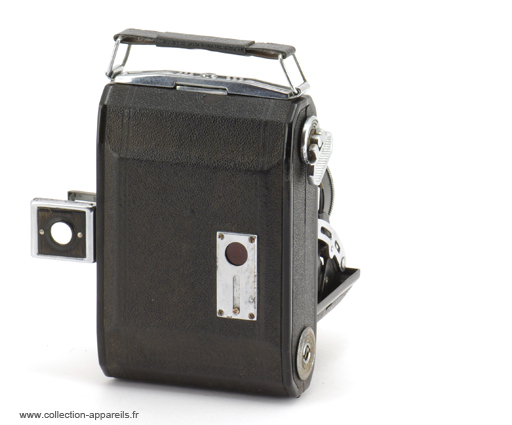|
Konica Semi Pearl |
Manufactured or assembled in Japan from (Circa) 1948 to (After) 1949.
Index of rarity in France: Rare (among non-specialized garage sales)
Inventory number: 7086
See the complete technical specifications
Chronology of cameras Konica
Le Semi Pearl original date de 1938, et a subi, au fil du temps, plusieurs remaniements. Les premiers auront des arêtes chromées et deux fenêtres inactiniques au dos. Puis au début des années 40, les arêtes seront peintes en noir. Vers 1943, le marquage initial "Rokuo-Sha" sera remplacé par "Konishiroku", suite à une réorganisation de la société.
La situation n'est pas très claire à propos des dernières années de la guerre, mais il semble que la production ait été interrompue, ou sans doute destinée à des applications militaires comme dans d'autres entreprises. Il y a dans tous les cas une période de transition à partir de '46, où sortiront des appareils montés avec ce qui était disponible. C'est ainsi, alors que la majorité des Semi Pearl sont équipés d'une hélicoïde de mise au point, qu' il y aura une série avec mise au point par déplacement de la lentille frontale.
Ici, nous avons la toute dernière version, sortie vers 1948. Les éléments caractéristiques sont :
- une seule fenêtre inactinique.
- marquage "Konishiroku" sur la face de l'obturateur et sur la cuirette du dos.
- mise au point par hélicoïde.
- façade de l'obturateur directement sérigraphié, sans plaquette vissée.
Cette version sera produite jusque vers 1949-50, remplacée ensuite par le Pearl I de format identique mais équipé d'un télémètre.
Le gros bouton à main droite, que l'on pourrait prendre pour le déclencheur, commande en fait l'ouverture de l'abattant. Le déclencheur, lui, est curieusement positionné sur le côté de celui-ci, et il fait furieusement penser à un vulgaire clou !
Commandé par l'ouverture de l'abattant, le viseur se déploie seul: l'appareil est alors prêt à l'emploi. La mise au point, ici graduée en mètres, se fait par une superbe hélicoïde commandée par le bouton strié que l'on voit au dessus.
L'ergonomie de ce type d'appareil est assez déconcertante : en effet, quand il est à l'horizontale, on fait des photos... verticales. Et quand il est vertical, je vous laisse deviner dans quel sens sont les photos !
De plus, le déclencheur se trouve à gauche. A la limite, l'appareil tenu verticalement (pour des photos... horizontales), on peut s'arranger, en le tenant par dessous, à déclencher avec la main droite (mais il ne faut pas avoir d'arthrose).
Comme beaucoup d'appareils similaires, le Semi Pearl ne possède qu'un écrou de pied, sur le côté. Il est curieusement au pas du congrès, mais possède ici un réducteur. Pour des photos en format paysage, il faudra donc poser l'appareil verticalement sur une surface horizontale : table, muret, rebord...
De là vient sans doute le terme de pose en photographie, qui n'est pas une pause pour autant.
Le revêtement de la poignée n'est pas d'origine, il ne subsistait plus que l'armature en feuillard métallique.


History
1873 Establishment of the Konishi-ya company. Initial implementation of photographic and lithographic materials.
1876 Relocation to Tokyo. The company is renamed Konishi Honten.
1882 Three factories are established in Tokyo, producing photographic equipment, coated paper, and lithography equipment.
1897 Introduction of the first cinematographic cameras in Japan, enabling the production of Japanese films.
1902 Establishment of a new factory in Tokyo dedicated to the production of photographic plates and papers. This factory is considered the birthplace of the Japanese photographic industry.
1903 The first photosensitive paper produced in Japan, Sakura Hakkin type paper, and the Cherry camera are introduced to the market.
1909 Opening of the Osaka Agency. Introduction of the LiIy camera.
1919 Consolidation of factories in Tokyo, forming Japan's first modern photographic organization.
1921 This organization becomes the Konishiroku Honten Company (Honten = headquarters).
1925 Introduction of Pearlette cameras.
1929 Launch of Sakura films (Sakura = Japanese cherry blossom).
1933 Expansion of the headquarters.
1936 The company becomes Konishiroku Co., Ltd. Opening of an agency in Hino, and relocation of the Sensitive Materials Production Division.
1938 Introduction of the Semipearl camera.
1940 Announcement of the production of the first Japanese color film, Sakura Natural Color Film.
1943 The company adopts its current name, Konishiroku Photo Industry Co., Ltd., and the factories are renamed.
1944 Merger with Showa Photo Industries Co., Ltd., adding the Odawara and Koyama factories to the company.
1945 End of the war, leading to a chaotic economic situation. A major reorganization is undertaken to enable the company to survive this tumultuous period.
1948 Sale of the first KONICA-branded cameras and resumption of exports.
1963 Inauguration of the large factory for the production of photographic equipment.
1967 Introduction of the world's great innovation, the SAKURACOLOR N-100, along with the world's first automatic reflex, the KONICA AUTO-REFLEX.
1968 The first automatic reflex camera (EE) incorporates through-the-lens (TTL) metering: it becomes the KONICA AUTOREFLEX T. Production of the first Japanese 24 x 36 compact rangefinder camera, the KONICA C35, in the same year.
1969 Development by Konishiroku of the world's first compact holographic camera.
1970 Start of the sale of U-Bix electrostatic dry photocopying machines. Introduction of SAKURA High Resolution Plate, ultra-fine grain, high-resolution sensitive material essential for Integrated Circuit manufacturing.
1971 Introduction of the new SAKURACOLOR. Commencement of U-Bix MARK I export.
1973 Celebration of the 100th anniversary of the company. Adoption of the new logo. Departure for a new century with renewed enthusiasm.
Interesting links or bibliography :
Add a link or element of bibliography, a picture taken with this camera, a picture of box or an ads about this camera
Your photos taken with the same camera:
Cameras from Ebay France (Konica) (Uploaded each 3 hours)


























